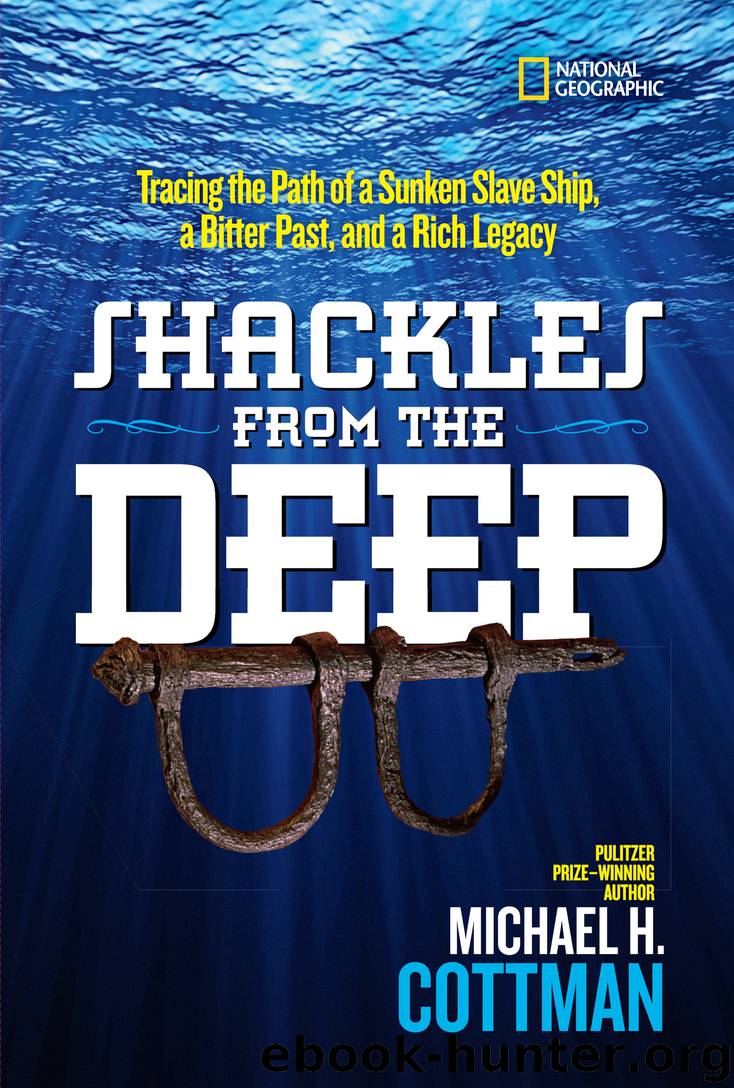Shackles from the Deep by Michael Cottman

Author:Michael Cottman
Language: eng
Format: epub
Publisher: National Geographic Society
Published: 2017-01-02T16:00:00+00:00
CHAPTER 10
Learning expands great souls. ∼ Namibian proverb
I WAITED FOR A FLOCK of black-bellied sheep to cross the road in Bridgetown, Barbados, before I could walk into the Department of Archives and continue the next stage of my research.
Back in London, I had learned that the Henrietta Marie anchored in Carlisle Bay, a harbor in Barbados, on July 9, 1698.
By the time the Henrietta Marie arrived in the West Indies after its first slaving voyage to Africa, she was a storm-battered ship creaking in the harbor. The three-month voyage from West Africa had taken its toll on the ship, its crew, and the enslaved Africans, many of whom died during the Atlantic crossing.
The Department of Archives in Barbados is located near the banks of the Atlantic Ocean. It is a breathtaking site, with azure waters that stretch outward from pristine white sand beaches. It looked like a tropical paradise, but I couldn’t help thinking about how it became a living hell for untold numbers of enslaved Africans.
I brought along photocopies from slaving journals to compare to research material I found in Barbados. Shipping records from the late 1600s indicated that the Henrietta Marie delivered “250 negro slaves and 150 elephants’ teeth” here as part of its first voyage.
Glorious humans and magnificent animals perished. Did the people involved in the slave trade really think this was okay?
I reviewed Nigel Tattersfield’s research: Barbados was the Henrietta Marie’s first port of call, and the African men and women were sold at public auction. Of the some 250 slaves on board, more than half of them—188—were consigned to a wealthy slave merchant named William Schuller.
Schuller was a prominent Barbados citizen who paid an average of £19 for each enslaved African—a total of £3,589. After being invasively inspected, the “healthy” Africans were taken to a nearby warehouse where they were forced to work the sugar plantations in Barbados—cutting down sugarcane stalks from dawn to dusk.
I was captivated by the islands in the Caribbean and how they played such a major role in the history of the Henrietta Marie.
Sugar, nicknamed “white gold,” was a lucrative business in the Caribbean back then, and the African labor force was an important backbone of the Caribbean’s commerce and profit margin.
Because of this, slave owners were incentivized to get the most labor possible out of each worker. They were not tolerant or understanding. They forced African men and women to work sometimes 16 hours a day in the sweltering sun.
And there were a lot of rules. Africans were not allowed to practice their rituals from Africa; they were not permitted to attend religious services in Barbados; and oftentimes they were not even allowed to speak to one another.
Reviewing further notes from Tattersfield, I found an account by a missionary named Father Labat who visited Barbados around the time the Henrietta Marie anchored in Carlisle Bay in 1698.
He wrote:
The English take very little care of their slaves and feed them very badly…The overseers make them work beyond measure and beat them mercilessly…and they seem to care less for the life of a Negro than a horse.
Download
This site does not store any files on its server. We only index and link to content provided by other sites. Please contact the content providers to delete copyright contents if any and email us, we'll remove relevant links or contents immediately.
The Mayflower and the Pilgrims' New World by Nathaniel Philbrick(4281)
Bloody Times by James L. Swanson(4242)
I'm Still Scared by Tomie dePaola(4214)
Pocahontas by Joseph Bruchac(4028)
Bomb: The Race to Build--And Steal--The World's Most Dangerous Weapon (Newbery Honor Book) by Steve Sheinkin(3711)
Flesh and Blood So Cheap by Albert Marrin(3670)
An American Plague by Jim Murphy(3631)
Little Author in the Big Woods by Yona Zeldis McDonough(3388)
The Giant and How He Humbugged America by Jim Murphy(3288)
Hello, America by Livia Bitton-Jackson(3013)
The President Has Been Shot!": The Assassination of John F. Kennedy by Swanson James L(2972)
Harry Potter: A History of Magic by British Library(2935)
The Landing of the Pilgrims by James Daugherty(2816)
The Extraordinary Suzy Wright by Teri Kanefield(2591)
Gettysburg by Iain C. Martin(2576)
Ben Franklin's Almanac by Candace Fleming(2382)
The Impossible Rescue by Martin W. Sandler(2213)
Bloody Times: The Funeral of Abraham Lincoln and the Manhunt for Jefferson Davis by James L. Swanson(1983)
Who Was Louis Braille? by Margaret Frith(1883)
